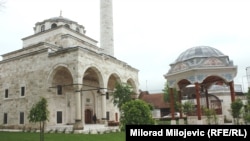In the middle of the night on May 7, 1993, the centuries-old Ferhadija Mosque in Bosnia-Herzegovina's city of Banja Luka was blown up. A few minutes later, there was another explosion, this time in the city's second mosque, Arnautija. The two buildings were completely destroyed.
A friend of mine whose apartment was roughly between the two mosques told me at the time that the windows of nearly all the buildings in the area were shattered by the blasts. All except for the windows of the Republika Srpska Interior Ministry, which locals surmised had been opened ahead of the explosions.
This week, on the 23rd anniversary of that fateful night, the rebuilt Ferhadija Mosque will be officially reopened, a project 15 years in the making. It is an event comparable to the 2004 reopening of the destroyed Mostar bridge or the restoration of the Sarajevo City Hall in 2014. Around 20,000 people are expected to attend the ceremony on May 7. Milorad Dodik, the president of Republika Srpska who is notorious for his nationalist rhetoric urging separation from Bosnia, recently visited the new mosque and donated three beautiful Persian carpets.
What seemed highly implausible when first proposed in an atmosphere of rancor and intolerance in 2001 has now become a reality. It almost seems like a miracle appropriate for a house of worship.
As is usually the case in the Balkans, a little history is important. Banja Luka is Bosnia's second-largest city, and for more than four centuries, the Ferhadija Mosque was one of its dominant landmarks. The mosque, like Mostar's famous bridge, was a masterpiece of 16th-century Ottoman architecture. According to legend, when Ferhadija was completed in 1579, Ferhat-Pasha, who had commissioned the work, had the builders locked inside the minaret, sentencing them to death so that they could never again make anything so beautiful. But one night they made wings and flew away.
Ferhadija was declared a cultural heritage site in 1950 and was under UNESCO protection until its destruction in 1993. No fighting took place in Banja Luka during the 1992-95 Bosnian war, but the city was subjected to deliberate and systematic ethnic cleansing. That term -- ethnic cleansing -- is too bland to describe the horror it contains. For the wartime leaders of Republika Srpska like Radoslav Brdjanin and Radovan Karadzic, both convicted in The Hague of crimes against humanity and genocide, a "clean" city was a city totally without Muslims and Croats.
The obliteration of Banja Luka's non-Serbian cultural heritage was a prelude to driving out the people. When the war began, the city's Muslims lost their jobs. Their property was confiscated. They were told to leave the city. By blowing up Ferhadija, the Serbian authorities sent a clear message to Muslims: your place of worship is gone and soon no one will even remember you were here. Most of the remaining Muslims left and the rubble of Ferhadija was cleared away.
Painstaking Restoration
But history is not so easy to pave over. Permission to rebuild the mosque was granted in 2001, although the construction process was not always smooth. The financing has been complicated -- a mixture of Bosnian state funds, private donations, and money from Turkey. The initial attempt to lay a foundation stone in 2001 resulted in rioting that left more than 30 people injured.
Rebuilding was a complex and laborious feat. Activists tried to locate the rubble from the original masterpiece. Some of it had been dumped in the Vrbas River. The rest was found in Banja Luka's garbage dump. Painstakingly, the rubble was gathered and the stones from Ferhadija and Arnaudija were separated one by one.
Muhamed Hamidovic, a professor at the Faculty of Architecture in Sarajevo, was a key driver of the project. As a student in the 1970s, he often traveled to Banja Luka and made a number of drawings of Ferhadija. Although at the time he was only interested in the building's sublime design, his measurements and drawings proved crucial in bringing it back to life.
Over 3,500 separate stone fragments were eventually recovered. Software was developed to help place each fragment in its proper place. In the end, about 65 percent of the new mosque was built of stones from the original, Hamidovic told N1 television.
Hamidovic's efforts were rewarded in January 2014, when the first worshipers prayed in the still-unfinished building. "I watched three people whispering their prayers," Hamidovic said. "There was no sound, no echo. All the sound was rising into the dome, where the voices, the incantations, mixed and collided with one another -- just like in the old Ferhadija." Listening to his words, one can't help but remember the legend of the mosque builders who escaped death on wings of beauty.
When the war in Bosnia ended in 1995, almost all of Banja Luka's Muslims and Croats -- about 30 percent of the prewar population -- had left the city. Even today, few have returned to Republika Srpska's capital. The prewar Muslim population of about 30,000 has shrunk to just a few thousand.
Recently, I met a girl from Banja Luka in Prague. She was born after the war -- a smart, well-educated girl. "Is it true that people of different ethnic groups lived together in Bosnia before the war?" she asked me. Her question was a disheartening reminder of the successes of wartime ethnic cleansing and the reality of Bosnia's postwar ethnic divides.
Ultimately, though, the opening of Ferhadija is a sign of hope. It is one of those rare moments when I believe that Karadzic and his like -- who sowed the seeds of hate and violence -- have not won the war.






